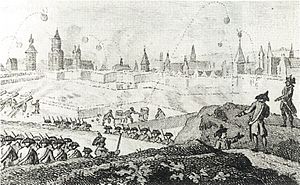Siege of Maastricht (1793) facts for kids
Quick facts for kids Siege of Maastricht (1793) |
|||||||
|---|---|---|---|---|---|---|---|
| Part of the Flanders campaign in the War of the First Coalition | |||||||
 Bombing of Maastricht, 1793 |
|||||||
|
|||||||
| Belligerents | |||||||
|
|
|||||||
| Commanders and leaders | |||||||
| Strength | |||||||
| Casualties and losses | |||||||
| Unknown | Unknown | ||||||
The Siege of Maastricht was a battle in 1793 where the French army tried to capture the city of Maastricht. This happened during the War of the First Coalition, a big conflict involving many European countries. The French attack failed, and the city was successfully defended by Dutch soldiers, helped by some French Royalists.
Contents
The Siege of Maastricht
On November 29, 1792, a French officer named John Skey Eustace sent a letter to the commander of Maastricht. He demanded that any French people who had sought safety in the city be handed over. Eustace then visited Maastricht and had dinner with the German commander. Because of this, he was removed from his command. A few days later, Francisco de Miranda took over.
This siege was one of several attacks by the French Republic between 1792 and 1793. After winning battles in the Austrian Netherlands, France declared war on the Dutch Republic and England on February 1, 1793. General Charles-François Dumouriez led an invasion of the Dutch Republic. He aimed for Breda. Meanwhile, General Miranda moved along the Meuse river towards Maastricht.
French Attack on Maastricht
Maastricht was a very strong city with many defenses. Miranda hoped to capture it quickly with only 15,000 soldiers. He surrounded the city, focusing on the Wyck suburb. The Dutch army defending Maastricht had 4,500 soldiers. They were led by Prince Frederick of Hesse-Kassel, the city's governor.
About 1,200 French Royalists also helped defend the city. These were people who supported the old French monarchy. They included 300 officers from the Armée des Émigrés, led by fr:Jean Thérèse de Beaumont d'Autichamp. He was a former cavalry general from the French royal army.
The Bombing of the City
On February 6, Miranda completely surrounded Maastricht and Wyck. His soldiers spent about two weeks digging trenches and tunnels. After this, the city was heavily bombed for ten days. More than 800 buildings in Maastricht were destroyed during this intense attack.
A French leader named Jean-Marat blamed Eustace and Miranda for the failure of the siege. General Dumouriez even planned to send Miranda to Paris to explain his actions. However, Eustace ignored orders and claimed to be very sick. He went to the Tongerlo Abbey and avoided being questioned or arrested.
Retreat of the French Army
On March 1, the Austrian army won a battle nearby at Aldenhoven. This meant the French army around Maastricht was now surrounded. About 50,000 Austrian soldiers and 20,000 Prussian soldiers, led by Prince Josias of Saxe-Coburg-Saalfeld, attacked the French lines.
Because of this new threat, Miranda ordered his troops to retreat on March 2. Some people described this retreat as a "flight" because it was so sudden.
On September 4, Prince Coburg entered Maastricht in a grand parade. A special church service was held in the Church of Saint Servatius to celebrate the victory. About a year and a half later, another French general, Jean-Baptiste Kléber, successfully captured Maastricht. He took the city in 45 days. After that, Maastricht was part of France for twenty years.

